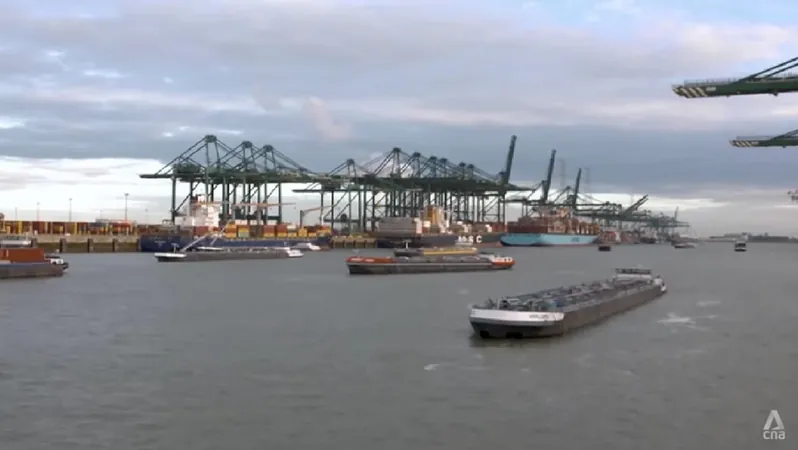
The Future of Shipping: Are Autonomous Ships Set to Transform Maritime Transportation?
2025-03-25
Author: Ming
The Future of Shipping: Are Autonomous Ships Set to Transform Maritime Transportation?
SINGAPORE: The shipping industry is on the brink of a technological revolution, as autonomous vessels begin to reshape the way goods traverse the world’s oceans. With around 90% of global trade carried by sea, the impact of these innovations could be significant.
The market for autonomous ships experienced over 5% growth last year and is projected to explode, potentially reaching a remarkable 30% increase by 2028. As they operate independently from human control, these crewless ships leverage cutting-edge sensors, navigation systems, and artificial intelligence to enhance operational efficiency.
However, despite the rapid advancements, experts agree that the widespread deployment of large, fully autonomous ships remains a long-term vision. Increased investment and clearer regulations may pave the way for this transformation, providing a firmer foundation for the industry's future.
The global autonomous ship market is anticipated to surpass USD 10 billion by 2029, up from USD 7.7 billion last year, signaling a robust demand for this revolutionary technology. Leading the charge, the Asia-Pacific region is experiencing a surge in technology uptake driven by a legacy of shipbuilding expertise, significant investments, and extensive maritime operations. Gianmatteo Barbieri, general manager at L3Harris Technologies, noted that the region is quick to adopt new technologies due to its historical context of maritime trade.
Another key advantage of autonomous ships is their ability to optimize travel routes, enhancing navigational efficiency and saving fuel. Francis Zachariae, Secretary-General of the International Organization for Marine Aids to Navigation (IALA), pointed out that most maritime accidents arise from human error, making a strong case for automation to improve safety. He likened the potential of autonomous shipping to the advancements made in aviation, where digital solutions have significantly supported pilots.
The industry's growing interest in autonomous navigation is further fueled by a shortage of qualified seafarers and the economic benefits of reducing crew expenses. In Japan, for instance, many seafarers are increasingly aging, with the average age ranging from 60 to 65 years. Neil Roberts from the Lloyd's Market Association highlights this crew crisis, suggesting automation could serve as a viable solution to the workforce shortage.
While innovation is cooking, experts caution that the extensive rollout of large fully autonomous vessels is still a distant reality. The world's first fully electric container ship, MV Yara Birkeland, launched in 2022, currently completes two weekly voyages with a minimal crew of three. Plans are underway to increase its operation to five voyages per week, manned with only two crew members.
Experts foresee a mixed fleet scenario persisting for the next two to three decades, where traditional crewed vessels will coexist with an increasing number of autonomous ships. “It’s far in the future,” Zachariae warned, emphasizing that newly constructed ships could remain in service for decades to come, and issues surrounding reliability, communication, and cybersecurity also need thorough addressing.
Yuichi Sonoda, Secretary-General of the Asian Shipowners' Association, expressed concerns about the safety of maritime communication, emphasizing the need for seamless interaction between autonomous ships and control centers. Furthermore, the challenges of operating these vessels in congested shipping lanes like the Straits of Malacca and within busy ports cannot be overlooked.
To ensure that advancements in autonomous technology align with global trade safety standards, the international maritime community is working to formulate uniform regulations. However, as Zachariae points out, achieving harmonized solutions is a formidable challenge due to differing priorities among nations and companies.
In conclusion, while the road ahead for autonomous shipping is laden with obstacles, the prospect of a safer and more efficient maritime future persists. As regulatory frameworks evolve and technology progresses, we are likely witnessing the dawn of a new era in global shipping—one where innovation meets the ocean's vastness. Stay tuned for more updates as we track this transformative journey!

 Brasil (PT)
Brasil (PT)
 Canada (EN)
Canada (EN)
 Chile (ES)
Chile (ES)
 Česko (CS)
Česko (CS)
 대한민국 (KO)
대한민국 (KO)
 España (ES)
España (ES)
 France (FR)
France (FR)
 Hong Kong (EN)
Hong Kong (EN)
 Italia (IT)
Italia (IT)
 日本 (JA)
日本 (JA)
 Magyarország (HU)
Magyarország (HU)
 Norge (NO)
Norge (NO)
 Polska (PL)
Polska (PL)
 Schweiz (DE)
Schweiz (DE)
 Singapore (EN)
Singapore (EN)
 Sverige (SV)
Sverige (SV)
 Suomi (FI)
Suomi (FI)
 Türkiye (TR)
Türkiye (TR)
 الإمارات العربية المتحدة (AR)
الإمارات العربية المتحدة (AR)